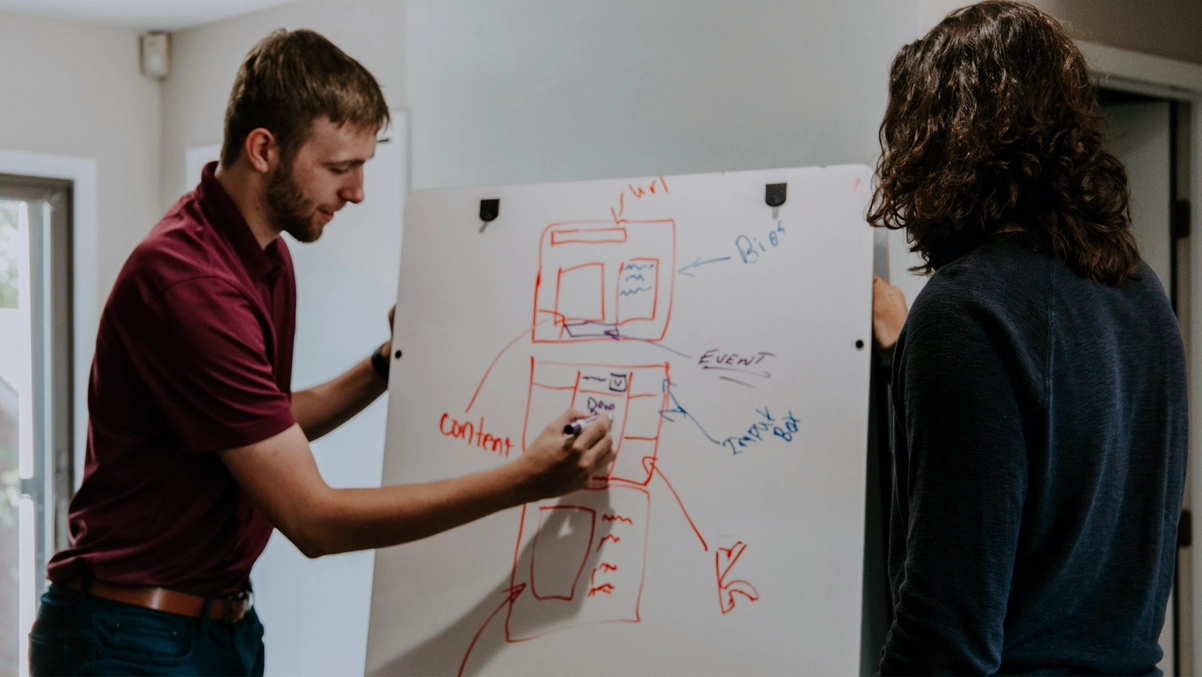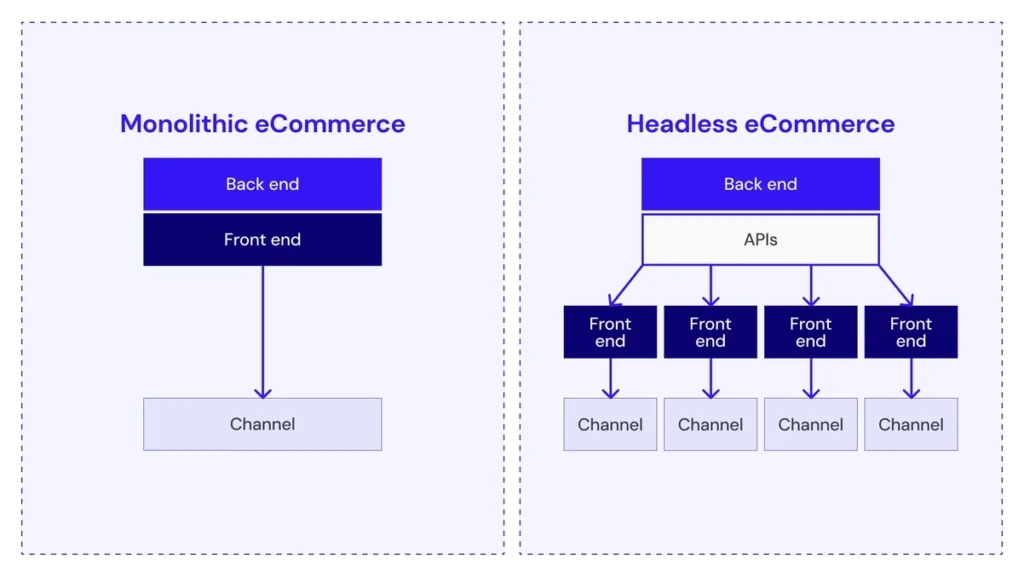How to improve content marketing with a headless eCommerce CMS
Aug 1, 2022 15–18 min read

Research shows that content marketing helps businesses generate leads, educate their audience, and build loyalty with existing customers.
Regularly publishing blogs, ebooks, newsletters, videos, podcasts, webinars, quizzes, and other types of content is crucial for brands that want to establish a far-reaching, authoritative digital presence. But the process of delivering and managing content can get complicated, particularly for companies that operate multiple websites across various target audiences and locales.
With a modern content management system (CMS) like Bloomreach , Contentful, or Drupal, marketers can streamline their content marketing strategy. These platforms come with a suite of tools that make it easy for admins to create, edit, organize, and publish content for different channels and audiences—all from a single dashboard. They also enable marketing teams to engage in SEO best practices, access customizable templates, and utilize version control or workflow management features. In other words, a CMS can be a critical tool for growing businesses that are looking to connect with their audience and drive down customer acquisition cost via content marketing.
However, traditional eCommerce systems may not provide the freedom and flexibility your growing business needs to optimize its front-end experience. With a monolithic eCommerce architecture, you can get locked into a CMS with limited functionality that doesn’t scale properly alongside your organization, resulting in cumbersome workflows, slow content deployment times, and ultimately a weak customer experience.
To support a fully optimized digital marketing strategy that lets your brand shine, consider implementing a headless CMS—as this approach provides unlimited freedom and flexibility when creating, distributing, and managing all types of content.
When a brand “goes headless,” they decouple their website’s front-end presentation layer from its back-end eCommerce functionality. This allows individual services within the technology stack to be managed and scaled independently, while communicating data and triggering actions between one another via APIs.

Unlike a traditional, monolithic architecture, headless systems enable marketers to make frequent additions and updates to the customer experience, without creating additional work for back-end developers. It also enables front-end teams to utilize whichever tools they prefer when building out the customer-facing UX and UI. And that’s where solutions like the headless CMS come into play.
Let’s say your business decides to ramp up its content marketing strategy, but is experiencing limitations with its current CMS. With headless, you can implement any modern CMS you want, without having to change other solutions in your tech stack. You can also implement other front-end solutions, like progressive web applications (PWAs), digital experience platforms (DXPs), and IoT devices to achieve the most effective customer journey. And again, updating your CMS—or integrating it with other front-end tools—will not have any impact on back-end functionality such as payment processing or inventory management.
A headless CMS frees your marketing team up to deliver more customized content in response to new industry trends and customer data, as well as experiment with different types of content like webinars, podcasts, and even virtual reality (VR) experiences.
Let’s dive deeper into the advantages of migrating to a headless architecture.
As mentioned, working with a headless CMS provides greater freedom and flexibility to marketers, designers, developers, and other front-end personnel. In particular, brands that go headless are more equipped to:
To maintain a professional and meaningful multi-channel customer experience, you must have consistent branding elements across your business’ website, mobile app, social media pages, and so on. With a headless CMS, you’ll have complete control over the look and feel of each touchpoint, from blog pages, to product detail pages, to checkout.
The process of creating and deploying new content—along with testing the performance of that content—becomes much more efficient with a headless CMS. Front- and back-end developers don’t need to collaborate on presentation-layer updates, which means marketers can more proactively embrace new industry trends, digital innovations, user data, and feedback.
A sophisticated CMS will collect and organize website data, so that marketers can better understand customer behavior. This may include which buttons get clicked the most, which parts of the site receive the lowest or highest amounts of engagement, and where users tend to fall off.
You can also integrate tools that capture specific information about individual customers, such as their age, gender, location, occupation, and browsing history. With this data, along with AI-powered tools, you can tailor the customer experience to satisfy your unique audience, and automatically deliver personalized content such as product recommendations, promotions, articles, and so on.
When it comes to internationalization, many brands working with legacy CMSs struggle to present their site in different languages, accept new forms of currency, and deliver localized content for specific regions.
For instance, due to order fulfillment issues or government regulations, you may only be able to sell certain products in certain countries—and your eCommerce site needs to display the correct product information to every customer, regardless of their location. Naturally, this gets increasingly complicated as your growing business sells more products to more customers in more territories. But with a headless CMS, you can manage numerous versions of the same site under one roof, and seamlessly customize each one with region-specific content.
Headless CMS architectures are inherently more scalable than traditional monolithic systems. By decoupling the front-end presentation layer from the back-end content management system, you can independently scale each component based on demand. This means your website can handle sudden spikes in traffic without sacrificing performance or the user experience. Additionally, with the ability to leverage cloud-based infrastructure and microservices, you can easily adapt to changing business needs and seamlessly integrate new features and functionalities as your eCommerce business grows.
In today’s digital landscape, consumers expect a seamless shopping experience across various channels, including websites, mobile apps, social media platforms, and even emerging technologies like voice assistants and IoT devices. With a headless CMS, you can efficiently manage content across all these touchpoints, ensuring consistent messaging and branding regardless of where customers interact with your brand. This enables you to implement omnichannel marketing strategies that drive engagement, loyalty, and ultimately, conversions.
Headless CMS architectures empower developers to innovate and experiment with new technologies, frameworks, and tools without being constrained by the limitations of a monolithic CMS. By separating content management from presentation, developers have the freedom to choose the most suitable technologies for each layer of the application stack, whether it’s React for the front end, Node.js for server-side logic, or GraphQL for querying data. This flexibility not only fosters creativity and innovation, but also enables faster time-to-market for new features and enhancements.
As technology continues to evolve at a rapid pace, it’s essential for eCommerce businesses to future-proof their infrastructure and adapt to emerging trends and technologies. Headless CMS architectures provide the flexibility and agility needed to embrace new innovations such as voice commerce, augmented reality shopping experiences, and machine learning-driven personalization. By decoupling content management from presentation, you can easily integrate these advancements into your eCommerce ecosystem without having to overhaul your entire infrastructure, ensuring your business remains competitive in the ever-changing digital landscape.
For some organizations, implementing a headless architecture is not worth the time and resources—typically because they’re already an established brand with loyal clients and minimal competition, and therefore don’t need to prioritize content marketing and the online customer experience. But for retailers and other businesses in highly competitive environments, headless eCommerce is the way of the future.
Consider going headless if your business is seeking to:
With a headless CMS, your brand can execute advanced content marketing strategies that allow your brand’s voice to be heard in a highly competitive D2C and B2B eCommerce landscape. So how do you get started? First, you need to implement a microservices or headless commerce architecture.
Here at Codal, we’ve helped numerous brands migrate from legacy eCommerce platforms to modern headless systems, enabling them to increase productivity and better connect with their customers through content. For example, we recently launched a headless solution for one of our clients in the outdoor gear space. And under this new decoupled system, their marketing team can efficiently create, publish, and manage personalized content for over a dozen websites, reaching audiences in a number of different countries—all from the dashboard of their headless CMS.
Our award-winning team has the technical experience and knowledge to plan and execute highly complex headless migration projects. We’re also partners with two of the leading headless eCommerce platforms on the market today, Shopify and BigCommerce—meaning we know how to get the most out of these technologies. With Codal on your side, you can establish a technological ecosystem that supports a powerful, data-driven content marketing strategy.

Explore our latest expertise on innovation, design, and technology, or connect with us directly to see how we can help accelerate your digital transformation.